The Toshiba Q300 SSD Review: Toshiba Becomes a Retail Brand
by Billy Tallis on February 26, 2016 8:00 AM ESTMixed Random Read/Write Performance
The mixed random I/O benchmark starts with a pure read test and gradually increases the proprotion of writes, finishing with pure writes. The queue depth is 3 for the entire test and each subtest lasts for 3 minutes, for a total test duration of 18 minutes. As with the pure random write test, this test is restricted to a 16GB span of the drive, which is empty save for the 16GB test file.
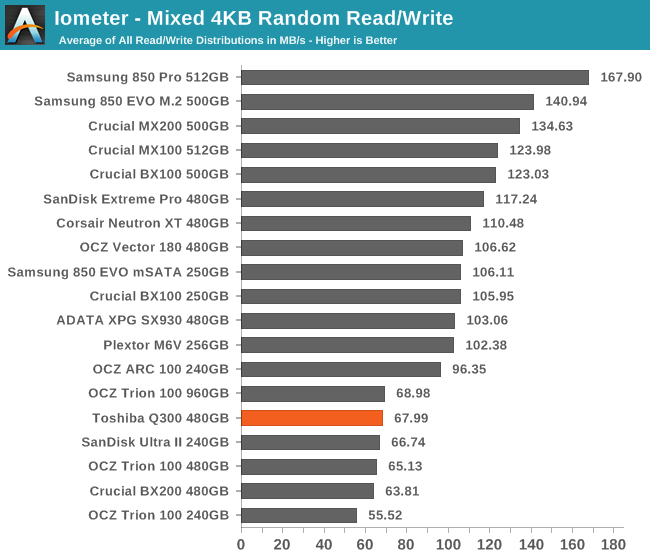
The planar TLC drives are clearly the bottom tier of mixed random performance, but the Q300's score is slightly above par by those standards. Despite using three different controller architectures, these drives all perform very similarly while the MLC drives have a fairly wide spread.
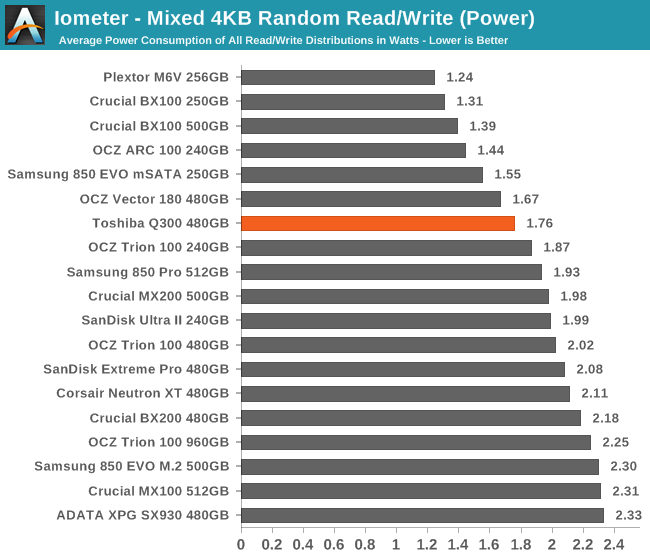
The Q300's power efficiency is significantly better than its planar TLC-based competitors and the power consumption in absolute terms is decent, but the MLC drives are mostly much more efficient due to much higher performance.
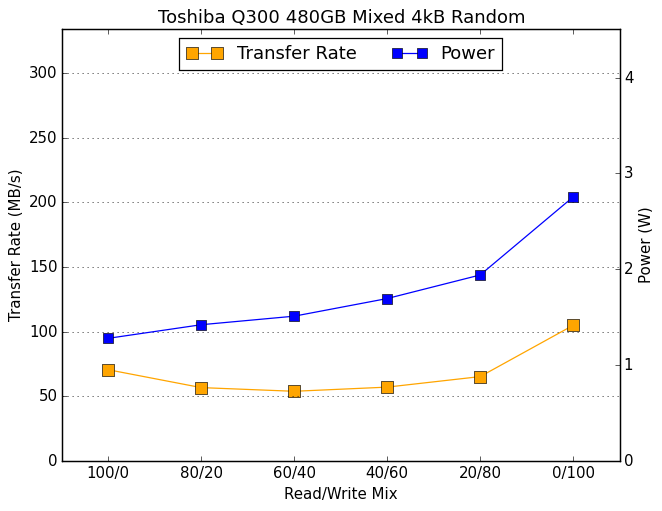 |
|||||||||
The slight drop in performance when writes are first added to the mix is not uncommon. What keeps the Q300's score low is that it does not exhibit large performance increases during the second half of the test, especially during the 100% write phase.
Mixed Sequential Read/Write Performance
The mixed sequential access test covers the entire span of the drive and uses a queue depth of one. It starts with a pure read test and gradually increases the proprotion of writes, finishing with pure writes. Each subtest lasts for 3 minutes, for a total test duration of 18 minutes. The drive is filled before the test starts.
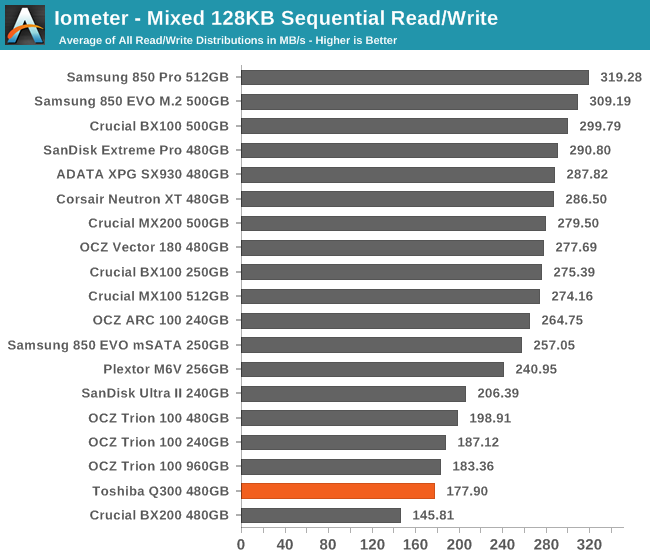
Unlike the random test, the Q300's performance on the mixed sequential test is clearly lower than the Trion 100, putting it in next to last place.
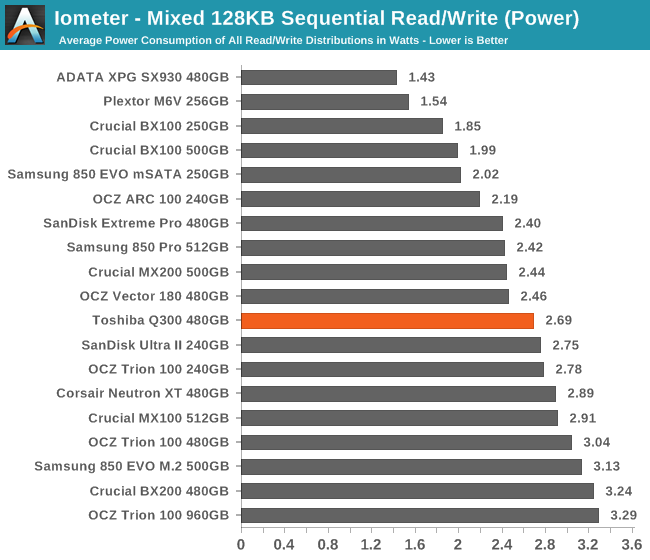
With middle of the road power consumption, the Q300's efficiency falls near the bottom, but the larger capacities of the Trion 100 and the Crucial BX200 are worse yet.
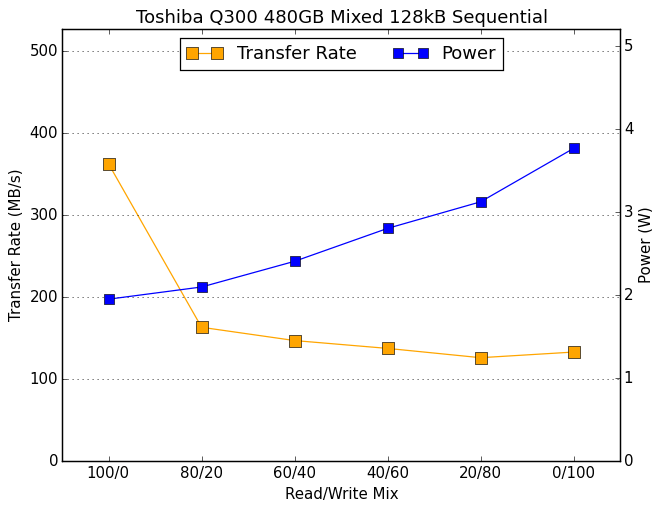 |
|||||||||
The Q300 isn't the only drive that doesn't recover performance at the end of the sequential test when the mix shifts toward pure writes. Its performance on the pure read phase at the beginning of the test is below almost every other drive except for the Crucial MX100 and MX200, which are redeemed by not dropping below 200MB/s in the later phases of the test. When writes are added to the mix, the Q300 drops to 163MB/s and keeps getting worse.










30 Comments
View All Comments
bill.rookard - Friday, February 26, 2016 - link
MX100's are awesome drives, I have a pair in my webserver with a M4 for the boot drive. Sadly, the whole issue appears to be (with the exception of Samsungs drives) the TLC. When having to account for the 8 different voltage states required for 3 bit per cell it seems that the controllers are not up to the task of getting things done quickly.I'm thinking widespread adoption of V-nand (regardless of manufacturer) along with MLC in a larger lithography will wind up being the perfect storm of capacity, price, speed and endurance.
Arnulf - Friday, February 26, 2016 - link
TLC cells have 8 distinct voltage levels per cell to make up for 3 bits of information, not 3.hojnikb - Friday, February 26, 2016 - link
thats what he said.kmmatney - Friday, February 26, 2016 - link
No, he said 3, not 3vladx - Friday, February 26, 2016 - link
"No, he said 3, not 3"Huh?
boozed - Friday, February 26, 2016 - link
It's really quite simple. He said 3, not 3.extide - Friday, February 26, 2016 - link
I think what we will see is 3D TLC in pretty much all mainstream stuff, and 3D MLC in the high performance stuff.Samus - Friday, February 26, 2016 - link
It's too bad the MX100 and BX100 are harder and harder to find, when the MX200 and ESPECIALLY the BX200 are inferior.leexgx - Friday, February 26, 2016 - link
the BX100 its perfect for laptops as its super power efficient, the MX100/BX100 is the most use the most power SSD (the Adata Sp550 also uses the BX200 controller)leexgx - Friday, February 26, 2016 - link
ops!! MX200/B200 or any SSD that uses TLC with SLC cache seem to be extremely high power usage, for minimal overall speed boost (and higher chance of data loss due to SLC/TLC data movement)